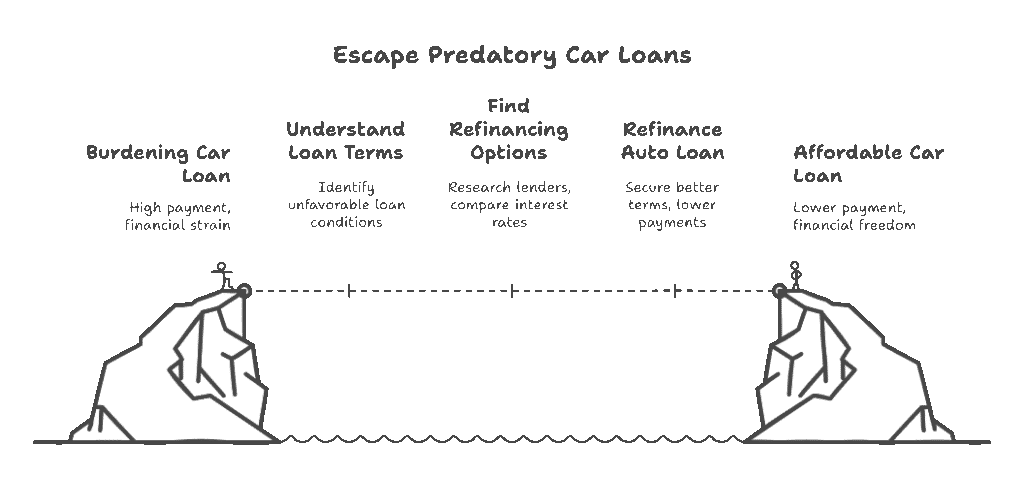The Smart Driver’s Guide to Car Loan Refinancing: How to Slash Your Payments Without the Hassle
We’ve all been there. That moment when the monthly auto loan payment hits your bank account, and you wince just looking at the numbers. What started as an exciting new car purchase has turned into a financial burden that just won’t shift gears.
Here’s something most drivers don’t realize: the car loan you signed at the dealership likely wasn’t designed with your best interests in mind. Those finance managers work on commission, and their job is to maximize profit-not to get you the best possible terms.
I’ve spent the last eight years helping people untangle themselves from predatory car loans. In that time, I’ve seen clients save anywhere from $800 to $15,000 on car-finance by simply car refinancing at the right moment. The process isn’t nearly as complicated as most lenders want you to think-if you know which levers to pull.
Let me walk you through exactly when, why, and how to refinance your auto loan so you can keep more money in your pocket each month.
Refinancing 101: It’s Not Just About Lower Rates
Most people think refinancing only makes sense when interest rates drop. That’s part of it, but there are actually five golden scenarios where swapping your loan could save you serious cash:
1. The Credit Score Jump
If your FICO has climbed 40+ points since you bought the car (common after paying down credit cards or other debts), you’re sitting on a hidden goldmine. Lenders reserve their best rates for borrowers with scores above 720-sometimes as much as 3% lower than subprime rates.
2. The Market Shift Play
When the Fed cuts rates, auto lenders scramble to stay competitive. But these changes take 6-8 weeks to trickle down. That creates a sweet spot where informed borrowers can lock in rates before the next economic report drops.
3. The Debt Consolidation Hack
Rolling high-interest credit card balances into your auto loan through refinancing can drop rates from 19% to 5% overnight. Risky if you rack up cards again, but brilliant for disciplined budgeters.
4. The Credit Union Loophole
Dealer-arranged loans average 2-3% higher than credit union rates. If you didn’t shop around initially, refinancing with a local CU could slash your APR immediately.
5. The Term Adjustment
Extending your loan from 48 to 60 months lowers payments (but costs more long-term). Shortening from 72 to 60 months saves interest while keeping payments manageable.
Pro Tip: Run an amortization calculator before deciding on new terms. I once saved a client $4,200 by refinancing from 72 to 60 months-her payment only rose $18/month, but she shed two years of interest.
The Refinancing Minefield: 4 Traps That Can Backfire
1. The Prepayment Penalty Surprise
Buried in your current loan agreement might be a clause charging 1-2% of the remaining balance for paying early. Always call your lender and ask explicitly about prepayment penalties before applying elsewhere.
2. The Extended Term Illusion
That 84-month loan might lower payments, but you’ll often pay more in interest than the car’s original value. Never extend beyond the vehicle’s expected lifespan.
3. The GAP Insurance Gotcha
If your original loan included GAP coverage, verify whether it transfers to the new loan. Driving without it could leave you underwater in a wreck.
4. The Hard Inquiry Haul
Each refinance application triggers a credit check. Too many in 30 days tanks your score. Get all quotes within a 14-day window-credit bureaus count these as a single inquiry.
The Step-by-Step Refinance Blueprint (With Insider Tricks)
Phase 1: The Financial Self-Audit
- Pull your credit reports from AnnualCreditReport.com (the only truly free site)
- Order your vehicle’s payoff amount (lenders often quote 10-day figures that exclude daily interest)
- Calculate your car’s private-party value using KBB and recent Facebook Marketplace listings
Why this matters: Knowing your exact loan-to-value ratio determines which lenders will work with you.
Phase 2: The Lender Three-Step
- Credit Unions First: DCU and PenFed consistently offer rates 1.5% below big banks
- Online Marketplaces Next: AutoPay and RateGenius aggregate dozens of lenders
- Your Current Lender Last: They’ll often match competitors’ rates to keep your business
Secret Weapon: Ask each lender for their “buy rate”-the base interest rate before markup. Negotiate from there.
Phase 3: The Paperwork Sprint
Lenders want:
- Latest pay stubs (or 1099s if self-employed)
- Registration showing no liens beyond your current loan
- Insurance cards proving full coverage
Time-Saver: Snap photos of docs with your phone-most lenders now accept digital submissions.
Phase 4: The Closing Checklist
- Verify the old loan is fully paid off (get this in writing)
- Confirm your title reflects the new lienholder within 30 days
- Set up autopay immediately (many lenders give a 0.25% discount)
Real Savings From Real People (Not Hypotheticals)
Case 1: The Teacher’s Turnaround Marisol was paying $478/month at 9.3% APR on her 2018 RAV4. After boosting her credit score 68 points and refinancing with a credit union:
- New payment: $396 at 3.49% APR
- Total savings: $5,904 over the loan
Case 2: The Uber Driver’s Edge Raj rolled $8,000 in credit card debt into his car refinance:
- Went from 22% credit card interest to 5.2% auto APR
- Cut monthly obligations by $217
- Paid off debt 3 years faster
When Refinancing Doesn’t Make Sense
1. The Depreciation Trap
If your car’s value dropped dramatically (think flood-damaged models or discontinued EVs), lenders may refuse to refinance.
2. The Short-Timer Exception
Within 12 months of paying off your loan? The fees likely outweigh any savings.
3. The Bankruptcy Shadow
Recent filings (under 2 years) restrict most refinancing options regardless of credit rebuild.
The Maintenance Mindset: Keep Saving After Refinancing
Treat your refinanced loan like a rotating credit line:
- Make biweekly payments instead of monthly (saves 6-12 months of interest)
- Apply tax refunds/work bonuses to principal
- Re-evaluate rates every 18-24 months
One client saved an additional $1,200 by refinancing twice in three years as rates kept dropping.
Your Action Plan Starts Today
- Right Now: Pull your current loan agreement and look for prepayment penalties
- This Week: Get free credit scores from Credit Karma + Experian
- Within 14 Days: Collect three lender quotes (credit union first!)
The auto loan industry banks on you staying put. Prove them wrong-your wallet will thank you.
Need a second set of eyes on your loan terms? Shoot me your details and I’ll spot hidden savings opportunities most borrowers miss.




